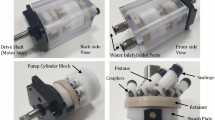Abstract
A water wheel is a device that converts the kinetic energy or potential energy of water flow into rotating mechanical energy. In ancient China, water wheels were used as the prime motor of shui dui (water power trip-hammer for husking rice), scoop waterwheel, waterpower roller (for grinding grain), waterpower grinder, boat mill, drainage machinery, water transport astronomical instrument, and so on.
Access this chapter
Tax calculation will be finalised at checkout
Purchases are for personal use only
Similar content being viewed by others
References
[The Eastern Han Dynasty] Huan Tan. Huan Zi Xin Lun. Si Bu Bei Yao (The Remarks of Four) (Photocopy). Beijing: Zhonghua Book Company, 1920: p. 17.
Zhang Baichun. Chinese traditional water wheels and their driving machinery. History of Natural Science, 1994, (2): p. 155–163; 1994, (3): pp. 254–263.
[The Northern Song Dynasty] Sima Guang. History as a Mirror. Beijing: Zhonghua Book Company, 1956: p. 2469.
[The Ming Dynasty] Xu Guangqi. Nong Zheng Quan Shu (An Encyclopedia of Agriculture). Beijing: Zhonghua Book Company, 1956: p. 367.
[US] Rudolf P. Hommel. China at Work: an Illustrated Record of the Primitive Industries of China’s Masses, Whose Life is Toil, and thus an Account of Chinese Civilization. Dai Wusan et al. (trans.) Beijing: Beijing Institute of Technology Press, 2012: pp. 86–89.
Zhao Nong. History of Chinese Art Design. Xi’an: Shaanxi People’s Fine Arts Publishing House, 2004: p. 181.
Joseph Needham. Science and Civilization in China (Vol.4, Part II). Cambridge University Press, 1965: p. 412.
Research Group of the Scientific and Technological History, the Library of Tsinghua University. Data Collection of the History of Chinese Science and Technology: Agricultural Machinery. Beijing: Tsinghua University Press, 1985: p. 307.
Research Group of the Scientific and Technological History, the Library of Tsinghua University. Data Collection of the History of Chinese Science and Technology: Agricultural Machinery. Beijing: Tsinghua University Press, 1985: p. 306.
[The Yuan Dynasty] Wang Zhen. Nong Shu (Vol.19, pp. 5B-6A). Si Ku Quan Shu (The Imperial Collection of Four) by Pavilion of Literary Profundity. Shanghai: Shanghai Classics Publishing House, 2003: pp.543–544.
Research Group of the Scientific and Technological History, the Library of Tsinghua University. Data Collection of the History of Chinese Science and Technology: Agricultural Machinery. Beijing: Tsinghua University Press, 1985: pp. 149–150.
Research Group of the Scientific and Technological History, the Library of Tsinghua University. Data Collection of the History of Chinese Science and Technology: Agricultural Machinery. Beijing: Tsinghua University Press, 1985: p. 160.
Research Group of the Scientific and Technological History, the Library of Tsinghua University. Data Collection of the History of Chinese Science and Technology: Agricultural Machinery. Beijing: Tsinghua University Press, 1985: p. 155.
Zhang Baichun. Chinese traditional water wheels and their driving machinery. History of Natural Science, 1994, (2): p. 155–163; 1994, (3): pp. 254-263.
Xianzhou, Liu. 1959. The full application of the gear train in ancient China. Journal of Tsinghua University 4: 1–11.
[The Western Jin Dynasty] Chen Shou. The Records of Three Kingdoms. [The Southern Song Dynasty] Pei Songzhi (Annotated). Beijing: Zhonghua Book Company, 1959: p. 807.
[The Southern Song Dynasty] Fan Ye. History of the Later Han Dynasty. [The Tang Dynasty] Li Xian, et al. (Annotated). Beijing: Zhonghua Book Company, 1965: p. 1094.
[The Western Jin Dynasty] Chen Shou. The Records of Three Kingdoms. [The Southern Song Dynasty] Pei Songzhi (Annotated). Beijing: Zhonghua Book Company, 1959: p. 677.
[The Yuan Dynasty] Wang Zhen. Nong Shu (Vol.19, pp. 5B-6A). Si Ku Quan Shu (The Imperial Collection of Four) by Pavilion of Literary Profundity. Shanghai: Shanghai Classics Publishing House, 2003: pp.544–545.
The identification group of ancient Chinese calligraphy and painting. (Ed.) Complete Works of Chinese Painting (3): The Song, Liao and Jin Dynasties (2). Hangzhou: Zhejiang People’s Fine Arts Publishing House, 1999: p. 16.
[The Tang Dynasty] Li Yanshou. History of the Southern Dynasties (420–589). Beijing: Zhonghua Book Company, 1975: p. 1774.
[The Northern Qi Dynasty] Wei Shou. History of the Northern Wei Dynasty (368–534). Beijing: Zhonghua Book Company, 1974: pp. 1476-1484.
Baichun, Zhang. 1994. The research of several traditional hydraulic machineries in Yunnan. Ancient and Modern Agriculture 1: 41–49.
Guan Xiaowu & Huang Xing. The waterpower grinder in Jiami of Tibet and the etiquette and custom of eating zanba (roasted qingke barley flour). In The Technology in Anthropology, Folklore and Industrial Archaeology. Beijing: Beijing Institute of Technology Press, 2009: pp. 119–137.
Author information
Authors and Affiliations
Corresponding author
Editor information
Editors and Affiliations
Rights and permissions
Copyright information
© 2020 Elephant Press Co., Ltd and Springer Nature Singapore Pte Ltd.
About this chapter
Cite this chapter
Huang, X., Zhang, B. (2020). Water Wheel. In: Hua, J., Feng, L. (eds) Thirty Great Inventions of China. Springer, Singapore. https://doi.org/10.1007/978-981-15-6525-0_11
Download citation
DOI: https://doi.org/10.1007/978-981-15-6525-0_11
Published:
Publisher Name: Springer, Singapore
Print ISBN: 978-981-15-6524-3
Online ISBN: 978-981-15-6525-0
eBook Packages: HistoryHistory (R0)




